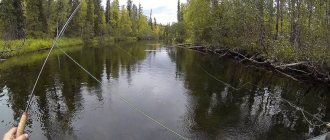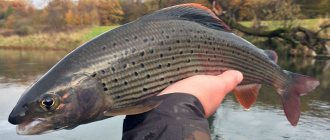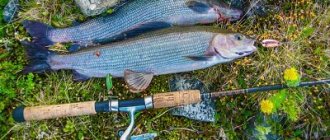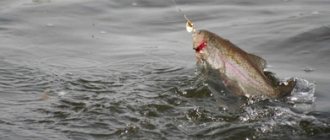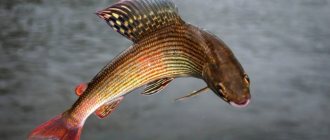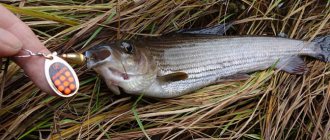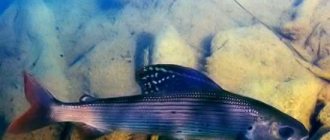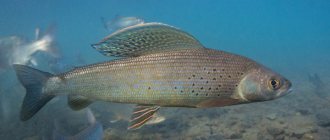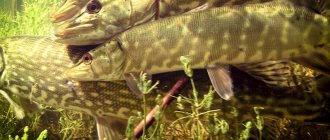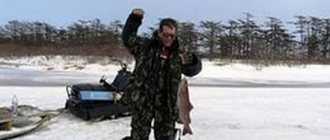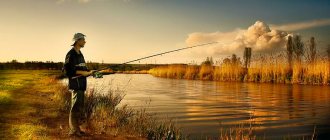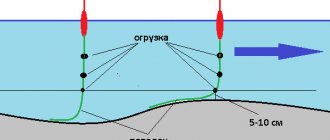Description
The rivers and lakes of the Polar Urals are practically not subject to fishing pressure due to their remoteness and wildness. This tour involves the use of snowmobiles. If our tourists want something exotic, then on some days they can use reindeer sleds to go fishing (by prior arrangement).
Nordural fishing guides warn that ice fishing for grayling in the rivers of the Arctic has its own specifics and features, which must be taken into account when preparing gear, when choosing equipment and personal clothing.
Firstly, we must take into account that fishing will take place in very sparsely populated areas. In the event of force majeure and, God forbid, some emergency, getting to civilization will be long and difficult. Therefore, we always send at least two snowmobiles on the route and our groups are always equipped with satellite communications.
Secondly, the rivers and lakes of the Bolshezemelskaya tundra are quite shallow and this must be taken into account when winter fishing. So, for example, for fishing drills you need to take 4-5 sets of spare knives. While drilling holes, there is a high probability of getting drilled into a rocky bottom, and in this case it is better to have spare knives. In addition, it is necessary to take into account the large thickness of the ice (this is a feature of winter fishing on the rivers of the Northern, Subpolar and Polar Urals). Sometimes the layer of water between the ice and the bottom is literally 10-12 cm, although the thickness of the ice can reach one and a half meters.
Thirdly, it is necessary to take into account the climatic and weather conditions of the Polar Urals. You must be extremely careful when choosing clothes for this tour. Before the group arrives, we make sure to give detailed recommendations regarding clothing and personal items.
In which Ural rivers does grayling live?
The rivers of the Urals, especially in its northern part, are home to many valuable and interesting fish such as grayling. Grayling, both Siberian and European, lives in the Ural rivers. We will mainly consider fishing for European grayling and its features in the Ural rivers.
Grayling fishing in the rivers of the Urals is especially popular, and fishermen from many regions of Russia come here to catch this wonderful fish. Indeed, even today, a significant population of grayling lives in the rivers of the Urals. However, you will have to go for it to sparsely populated places practically untouched by humans. Near large and small cities, the population of this fish has decreased significantly.
If we take, for example, the Perm region, then you will have to look for grayling at a distance of at least 400 km from the capital of the Perm region. The Vishera Nature Reserve is one of those places where grayling fishing in the rivers of the Urals
may be very promising. There are many rivers and rivers where grayling lives or migrates for the summer. It is believed that the largest concentration of European grayling is observed in the Vishera River basin today.
Ural rivers where grayling lives
North of Solikamsk (territory of the Northern Urals), grayling is found in almost all rivers flowing in this territory. Grayling fishing in the Vishera River
, is considered the most promising in these places. Especially in its middle reaches and upper reaches. Grayling is also well caught in the Kolva, Yazva, Berezovaya, and Molmys rivers, especially in the upper reaches of these rivers. This fish can also be caught in the upper reaches of such rivers as Moiva, Vels, Halsoria, Nilos and some others.
When is the best time to catch grayling?
Catching European grayling in summer
, and in early autumn, in the Northern Urals is the most productive.
The most promising fishing for grayling
begins in mid-August and continues until early October, and sometimes longer. It is at this time that grayling begins to accumulate reserves for the winter and actively fattens. Grayling caught during this period, having accumulated fat, is considered the most delicious. Therefore, it is best to come fishing for grayling at the end of August or in the first half of September. At this time, the tourist season is coming to an end; there are few rafting enthusiasts on the rivers and they are practically free. At the same time, insects, the main food of grayling, become fewer.
Of course, there are also some disadvantages here, the nights are getting colder and in September the temperature in the Northern Urals will drop to +5 C0, and by the end of September it may drop even more, even to 0,
Some anglers are very mistaken when they believe that grayling begins to be caught immediately after the ice melts. However, this is a misconception. During this period, the opening of the rivers occurs in early May and by this moment, after the winter fast, the grayling is already more or less satiated, and besides, it begins to spawn. Large grayling spawn first and at this time bite very sluggishly.
At this time, the water becomes cloudy, and often the grayling stops pecking altogether. Only in mid-June does the water begin to subside and grayling stop spawning. Based on these signs, anglers determine that grayling will soon begin to actively feed. However, until the end of the first summer month, grayling fishing in the Ural rivers
difficult to predict.
Grayling begins to bite more consistently in July and gradually its biting becomes more and more active. In the second half of August and September, the bite reaches its peak, and grayling fishing
in the rivers of the Northern Urals is the most successful during this period.
Fishing for grayling in winter
Fishing for grayling in winter
is not very popular.
During this period, grayling activity is quite low. It feeds sporadically and reacts sluggishly or not at all to bait. However, local fishermen with extensive experience in grayling fishing manage to catch 5 or more kg of grayling even during the dead of winter. But these are experienced fishermen who know perfectly well the habits of grayling and their permanent location in winter. Others are advised to come to the Ural rivers for grayling towards the end of April or in the middle, when the grayling begins its pre-spawning feast. In the first days of May, grayling fishing in the spring ends
, the ice, and at this time, becomes very unreliable and there is no point in taking risks.
Tackle and equipment for fishing for grayling
Grayling can be caught using a variety of gear, spinning, float and fly fishing gear, donka, and boat. It is caught both with artificial baits and natural baits, primarily with a worm.
Grayling sites
Successful fishing for grayling in the Ural rivers
, is possible if the fisherman knows well and has an idea where to look for it.
In winter, you need to look for grayling in deep holes, for this you need to know where these holes are located. Fishing for grayling in the spring, in the rivers of the Urals
, mainly occurs on stretches. And in summer and autumn, grayling is caught mainly on riffles, behind large boulders, in holes with a stream under rock formations, and at the entrances to a hole after a riffle.
Grayling fishing is very catchy
in places of oblique drainage. There the river is partially blocked by stones; usually behind them there is a hole and the main current passes through. There are several streams between the current and the stones, and the drainage under the pit is usually uneven. In such places, it is possible to catch grayling throughout the water area of the entire pit, as well as at the border of the main stream and the confluence of drainage streams.
Grayling fishing is very successful
and at the confluence of channels and rivers. If the drainage of the channel is blocked by boulders, and a riffle is formed, then a more powerful current of the river will create a backup for the stream emanating from the channel. On a river in such places, holes are usually washed out; at the bottom of such a hole, the flow speed will be equal to the speed of the main current, and at the top of the hole, the flow speed is minimal. Grayling in such places is caught, as a rule, at the confluence of streams, in the middle or upper parts of the hole.
The confluence of tributaries and streams into the river is one of the best places for fishing for grayling. Such places should always be given attention and carefully fished. Typically, in such places, grayling can be found in the pits that appear at the confluence.
Fishing for grayling on the return line,
will also be very promising. In this case, fish are caught in underground pits, where the main and return flows form a boundary. A reverse current can originate behind a rock formation that juts into the river when flows of different speeds merge.
Places after rapids and rifts are also very catchy, and they need to be given due attention. Large grayling likes to stand in such places, since there are quite deep depths and there are many large stones at the bottom. But here you will need heavier and more reliable gear.
Mostly medium and small grayling are caught on the reaches, where they usually prefer to feed. But there will be a lot of bites there.
Another promising place where there is a high probability of catching grayling is the islands. After bypassing the flow of the island, the speeds on its right and left sides become different, and already behind the island a visual boundary of the flow merging appears. It is on this border that grayling should be caught. On the side where a weaker flow passes through the river, it usually washes out the hole and the reverse current enters it.
Happy fishing!
Tour program
Day 1 ◦ Arrival of the group by rail to the city of Inta. You can also get to Inta by plane from Syktyvkar. ◦ Travel by car or snowmobile from Inta to the village of Petrun (95 km by car, 60 km by snowmobile). ◦ Accommodation in a village house. Dinner. ◦ Bathhouse. Walk.
Day 2 ◦ Early morning rise, hygiene procedures, breakfast. ◦ After breakfast, refueling the snowmobiles with fuel and loading things into the sleigh. ◦ Ice fishing on the lakes of the Polar Urals. The lakes contain large perch (there are a lot of perch, you can catch them in bags), pike, burbot, and some grayling. ◦ Lunch for fishing is prepared in camp conditions. ◦ If the group left the village of Petrun not far, then in the evening it is possible to return to the village for an overnight stay. If the group has gone a considerable distance, then they will have to spend the night either in a corral (the reindeer herders’ house and enclosure) or in a hunting winter hut. If the overnight stay takes place in the winter hut or in the corral, then the preparation of dinner will be independent.
Day 3 ◦ While fishing, the morning can be devoted to the morning bite. ◦ This day is completely dedicated to fishing and the fishing location will be determined by our guide. The Bolshezemelskaya tundra is incredibly rich in small rivers, lakes, and streams. This is where grayling fishing will take place. ◦ Our guides will definitely show you the most catchy baits, advise on gear and take the group to the pits where grayling spend the winter. ◦ The overnight stay will most likely take place in some reindeer herders’ house or in a farmstead.
Day 4 ◦ Breakfast. Departure to one of the rivers of the Bolshezemelskaya tundra. It makes no sense to give their names, because... firstly, there are a lot of them (some don’t even have names). Secondly, the names used by local residents (including our guides) do not coincide with the official ones and you will not find them on official maps. Our guides will definitely take you to certain holes where grayling spend the winter. ◦ The day will be devoted to fishing only until lunch. After lunch (which will be in the field, most likely in the form of a snack), the group must definitely move towards the village of Petrun. ◦ Evening bath, dinner.
Day 5 ◦ Early rise, breakfast, packing. ◦ Transfer by car or snowmobile from the village to the city of Inta. ◦ Upon arrival in Inta, the group goes to a cafe for lunch/dinner (depending on the time of day). ◦ If there is still enough time before the train departs, you can organize a tour of the city of Inta. ◦ After that, we take tourists to the station (located 20 km from the city) and put them on the train.
Grayling fishing in summer
Fishing for grayling in open water begins when the water after the flood returns to its normal level and becomes significantly lighter. In the spring, grayling is caught using all of the above equipment based on its habitat. With the onset of summer and the appearance of a large number of insects, they become the main component of the grayling diet. Summer fishing for grayling most often occurs using fly fishing or spinning.
In summer, grayling searches for food on the surface of the water and in the upper layers. On mountain rivers, searching for grayling can take considerable time. It’s not easy to find places where grayling are found. You can tell where this fish is concentrated by its splashes. The bait should lie next to the fish. Grayling prefers easily accessible prey and is unlikely to chase bait across the water area. It is best to catch grayling by wading, so the bait can be cast more accurately and the fish is not so cautious if a person is standing in the water and not on the shore.
Summer fishing for grayling is usually carried out on a variety of live insects or their artificial imitations. At the same time, grayling will be better able to peck at floating flies in the summer. With the arrival of August, grayling is much less likely to be caught on the surface of the water and should be looked for in the middle layers. fishing for grayling with wet flies has become relevant . They, unlike dry flies, melt on the surface when falling into the water, where they are supposed to imitate a drowning insect.
In August it is quite good to catch grayling using spinner spoons. They should not be large in size or heavy; ideally, a spinner for catching grayling should not exceed 5 cm in length and its weight should be a maximum of 7 g. The best models are those from Mepps with bright colors.
Price list
Tour duration: 5 days. Group: any, optimal number - up to 8 people. Cost: from 20,000 per person per tour.
The price of spring fishing includes: ✔ transfer by car or snowmobile to the village of Petrun ✔ services of a fisherman guide (choice of fishing spot, advice on gear and habits of grayling) ✔ rental of tourist equipment ✔ rental of snowmobiles with fuel and lubricants (with sleigh) ✔ accommodation in a village house ( with a bathhouse), in hunting lodges or reindeer herders' huts (corrals) ✔ food during fishing
Additional services: - rental of additional equipment - organization of licenses and permits for hunting (passing) during fishing (if the season is open) - relaxation in a cottage or at a recreation center with any cultural program - reindeer sledding - ethnographic excursion in the village of Petrun.
Prohibited periods and places for fishing in the Sverdlovsk region
The fishing rules on the territory of the Sverdlovsk region prohibit the extraction (catch) of aquatic biological resources during periods and in water bodies of fishery importance and their parts (with the exception of the extraction (catch) of aquatic biological resources with one bottom or float fishing rod and a spinning rod from the shore with a total number of hooks of no more than 2 pieces on the fishing gear of one citizen):
all types of aquatic biological resources:
- from April 25 to June 15 - in the reservoirs Chernoistochinsky, Verkhne-Makarovsky, Nizhne-Tagilsky, Lenevsky, Nevyansk, Verkhne-Vyysky, Nizhne-Vyysky, Verkhne-Saldinsky, Isinsky, Nizhne-Saldinsky, Petrokamensky, Beloyarsky, Volchikhinsky, Novo-Mariinsky , Ayatsky and Isetsky; lakes Melkoe, Tavatuy, Baltym; the Iset River from the source to the backwater of the Verkh-Isetsky reservoir and the Reshetka River;
- from May 15 to June 15 - in the reservoirs Artinsky, Nizhne-Serginsky, Verkh-Neyvinsky, Pogorelsky, Staroutkinsky, Afanasyevsky, Artinsky, Nizhne-Turinsky, Verkhne-Turinsky, Rezhevsky, Revdinsky, Mikhailovsky, Bilimbaevsky, Kushvinsky, Polevsky and Atigsky, and also in lakes Shitovskoye, Shartash, Chusovskoye and Dikoe;
- from May 1 to May 30 - in other water bodies of fishery importance in the region;
- from May 1 to June 15 in the Lozva River from the source to the mouth of the Bolshaya Umpia River;
whitefish:
- from September 20 to November 20 - in Lake Tavatuy;
Siberian grayling:
- from October 20 to November 15 - everywhere. That is, catching Siberian grayling is prohibited within the specified periods throughout the Sverdlovsk region.
Species of fish prohibited from catching in the Sverdlovsk region
In fishing (fishing) areas provided for the organization of recreational and sport fishing:
- Siberian sturgeon, nelma, common sculpin, brine shrimp, brine shrimp at the cyst stage;
Outside the fishing (fishing) areas provided for the organization of recreational and sport fishing:
- Siberian sturgeon, nelma, common sculpin, brine shrimp, brine shrimp at the cyst stage;
- sterlet, taimen, aquaculture objects.
Minimum size of fish caught in the Sverdlovsk region
When carrying out recreational and sport fishing, the extraction (catch) of aquatic biological resources having a fresh length less than that indicated in Table 35 (commercial size) is prohibited:
Minimum size of fish caught
Name of aquatic biological resources
| Length, cm | |
| Sterlet | 40 |
| Whitefish | 40 |
| Peled (cheese) | 26 |
| Ripus | 21 |
| Grayling | 26 |
| Zander | 35 |
| Carp | 30 |
| Pike | 30 |
| Bream | 23 |
| Ide | 23 |
The commercial size of fish is determined fresh by measuring the length from the top of the snout (with the mouth closed) to the base of the middle rays of the caudal fin.
Extracted (caught) aquatic biological resources having a length less than that indicated in the table above are subject to immediate release into the natural habitat with the least damage.
Read expert opinions
About the features of fishing described in the article
burbot
perch
grayling
pike
whitefish
